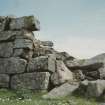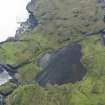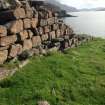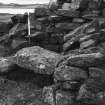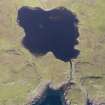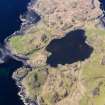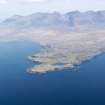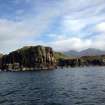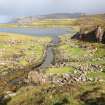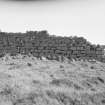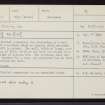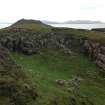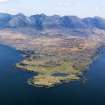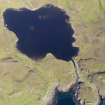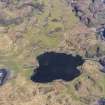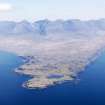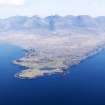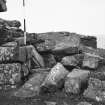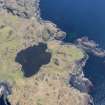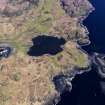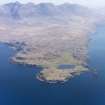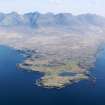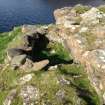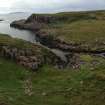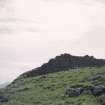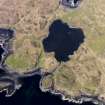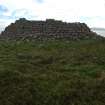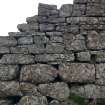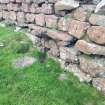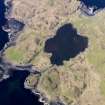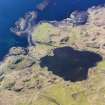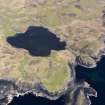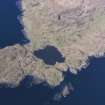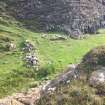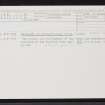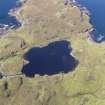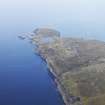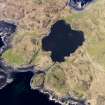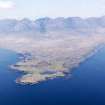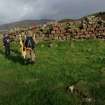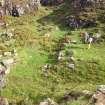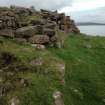Skye, Rubh' An Dunain
Galleried Dun (Prehistoric)
Site Name Skye, Rubh' An Dunain
Classification Galleried Dun (Prehistoric)
Alternative Name(s) Rudh' An Dunain
Canmore ID 11021
Site Number NG31NE 1
NGR NG 3958 1597
Datum OSGB36 - NGR
Permalink http://canmore.org.uk/site/11021
- Council Highland
- Parish Bracadale
- Former Region Highland
- Former District Skye And Lochalsh
- Former County Inverness-shire
Rubh' an Dunain
At the toe of this remote promontory, bounded by Loch Brittle and the Sound of Soay and reached only by a lonely track, lies a rich palimpsest of archaeological remains testifying to the former significance of Rubh' an Dunain. Chambered cairn, probably 2nd or 3rd millennium bc, a Neolithic passage grave. To its south, one of best preserved survivals of an Iron Age promontory fort (or galleried dun), with a portion of curved drystone wall to landward, possibly 1st millennium bc. A stone-lined canal, possibly Viking, connects a sheltered inlet to a small lochan, suitable for harbouring birlinns. Small former township, with round-ended ruin of early-mid 18th century tacksman's house, a two-storey chimney gable at one end. Still occupied in the 1860s, this was the home of the MacAskills of Rubh' an Dunain.
Taken from "Western Seaboard: An Illustrated Architectural Guide", by Mary Miers, 2008. Published by the Rutland Press http://www.rias.org.uk
NG31NE 1 3958 1597.
(NG 3958 1597) Dun (NR)
OS 6" map, Inverness-shire, 2nd ed., (1903)
A galleried promontory dun consisting of a wall cutting off a headland (Rudh an Dunain) which measures 80ft by 36ft in extent. The wall, built of large, squared blocks, is 12ft thick at the base and stands to a maximum height of approx. 9ft The entrance, near the N End, is checked for a door, and galleries can be distinguished within the wall.
RCAHMS 1928; R W Feachem 1963.
A galleried promontory dun as described above.
Visited by OS (C F W) 11 April 1961.
Field Visit (17 May 1915)
Dun, Rudh an Dunain.
On the seashore, about ½ mile east of Rudh an Dunain, the promontory at the extremity of the peninsula between Loch Brittle and Soay Sound, looking out to the island of Rum, is an elevated rocky plateau with precipitous sides rising over 50 feet in height above the sea on its southern extremity, and about 15 feet above a narrow neck on the landward side by which access to the summit is obtained. The extreme southern projection of the plateau is occupied by the remains of a dun, of which only a portion of the wall on the landward side remains. Though broken down at the ends and somewhat reduced in height, it is one of the best preserved examples of this class of defence in Skye. Any parapet which may have been erected round the edge of the cliff has disappeared, possibly with the erosion of the rock. The remaining wall is a fine specimen of drystone building and contains a number of interesting features (Fig. 296). It crosses the plateau in a convex curve towards the land, and is built of fine large blocks of stone laid in courses with a considerable inward batter on the outer side; on the inside the lower courses for a height of about 3 feet project about 9inches from the face of the wall above, forming what may be called a low scarcement. At the foundation the wall is about 12 feet thick and at the highest part 10 feet. The inner face for about half its length stands some 5 feet in height, and the outer face for the greater part reaches a height of 8 feet 6 inches ; in the centre however a short section measures 11 feet 3 inches in height above more than 1 foot of debris. The entrance, though much broken down, is clearly defined. It is placed about 12 feet from the northern end of the wall and measures 3 feet 1 inch in width at the outside. On either side of the entrance passage, some 3 feet 9 inches from the outside, is a door check 1 foot deep. The wall on the right side of the entrance, though almost reduced to the foundation, shows a width of 12 feet 3 inches. A large slab lying among the fallen stones in the passage, measuring 4 feet 6 inches in length, 2 feet 10 inches in breadth, and 11 inches in thickness, has probably been a lintel stone. A short distance south of the inside of the main entrance is a doorway leading into a narrow gallery built in the thickness of the wall. The doorway narrows towards the inside and about halfway in measures 2 feet 10 inches in width; one of its lintels remains in situ. The gallery in the wall is filled with stones, but at one part measures some 2 feet 10 inches in width, the outer wall being 3 feet 3 inches thick and the inner wall 3 feet 5 inches. To the south the outer wall at one part is 4 feet 9 inches thick. As the latter piece of building stands 4 feet higher than the top of the lintel over the door of the gallery, there seems to have been an upper gallery.
The interior of the dun is of small area and very irregular on plan, and measures about 80 feet across from cliff to cliff behind the wall, but towards the south contracts to a width of some 47 feet. From the inside of the wall to the southern edge of the precipice is about 36 feet. There is evidence of internal buildings within the dun but the shape of these is indeterminate.
RCAHMS 1928, visited 17 May 1915.
OS map: Skye xlix.
Publication Account (2007)
NG31 1 RUDH' AN DUNAIN
NG/396160 (visited 20/4/63 and in 1986).
This unexcavated promontory semi-broch is a classic site of its type and consists of a simple, gently curved wall barring the neck of a short, high cliff promontory in a very wild and remote part of south-west Skye. There is an abandoned two-storeyed house nearby (inhabited by the Macaskill family until about 1850 [4, 185]), and a Neolithic chambered tomb a few hundred yards away which was excavated by Sir Lindsay Scott in 1931 [4]. Scott also explored the nearby cave in 1932 [5] with results that probably have a bearing on the date of the Iron Age promontory fort (below). The name 'Rudh' an Dunain' is applied to the large promontory south-west of the site and means 'promontory of the fort'.
Situation
It is worth summarising Scott's comments on the remoteness and difficulty of access of this area [4, 132-33]. Contrary to what one might conclude from the presence of the two large prehistoric monuments, the inhabited cave and the abandoned house it is not easy to reach the small cultivable area on which they stand. Because the rugged, high Cuillins mountains lie immediately behind the site, and come down to the shore of Soay Sound to the east, the land approach involves a walk of three miles along the east shore of Loch Brittle, which itself is reached, from the head of Loch Harport, by way of the narrow pass of Glen Brittle. Coming by sea is not much easier because of the exposed nature of the Rudh' an Dunain (Scott gives details of possible landing places [4]: there is a boat port at the exit stream from Loch na h'Airde). The only cultivable ground nearby is the shallow valley running for just under half a mile west-south-west to Loch na h'Airde, a short distance north-west of the promontory fort.
Description
Although unexcavated this promontory semibroch could be providing important evidence both for the dating of its type and for the significance of semibrochs in the evolution of the broch type, as is explained below. Its full excavation is highly desirable.
The wall of the structure is fairly well preserved and is certainly not a “ruined ring” as thought by Childe [3, 198]; the diameter of a circular building of which this wall was a part would be something like 40-45m (up to 150 ft) – two-and-a-half times the size of the average broch. The fact that the wall narrows considerably as it approaches the cliff at the north-east end (furthest from the doorway) appears to confirm that the wall was never much longer than it is at present. Of course a huge amount of the cliff would have to have disappeared over the last two-and-a-half millennia if the structure was once a complete ring.
The entrance in the convex outer wallface – which has a pronounced batter – is near the right or south-west end and is 3.6m (12 ft) from the high and sheer cliff edge; it is just over 3.66m (12 ft) long and filled with rubble. Its lintels have disappeared but the door-frame is visible 1.14m (3 ft 9in) from the outside, where there are two well-built, opposed rebates in the walls; the bar-hole is not visible.
In the inner face, a short distance to the left of the inner end of the entrance (looking inwards), is the door to the mural gallery which runs along the rest of the wall to the opposite edge. The left side of this door is continuous with the end wall of the gallery which thus stops several feet short of the main entrance. One lintel remains over the door but none are visible over the gallery itself. However its walls rise well above this lintel to the wallhead, which is here 10-12 ft (3.0-3.6m) high above the level grassy surface outside; thus an upper as well as a lower tier of gallery must be preserved. A fine ledge scarcement 9 in (25cm) wide is preserved on the inner wallface; it runs along more or less level. It is not clear whether this ledge included the lintel over the doorway to the gallery but it seems probable.
The space enclosed by the drystone barrier is now quite small, measuring about 250 sq yds., but the area of the promontory may have been reduced by cliff falls since Iron Age times. Very large angular rock fragments can be seen under water below the cliffs.
Structural analysis
It has been noted before that, although the promontory defence is a simple curved wall, its hollow construction is of equal sophistication to that found in the broch towers [3]. The entrance passage is of standard broch design and the wall to the left of this appears to have two continuous, superimposed galleries in it (Levels 1 and 2). It is reached by a doorway from the interior of which the front lintel would probably once have formed part of the scarcement on the inner face. Doubtless there is a stair to the upper levels just to the right of the door but no steps are exposed.
No doubt there was once a chamber over the entrance passage and a void over the gallery door, both facing inwards, but nothing of these is preserved. However the fact that the wall has such a shallow curve means that the scarcement cannot have supported a two-storeyed wooden roundhouse in the interior and it must have had some other purpose. In this way Rudh' an Dunain is sharply distinct from the round towers and from D-shaped semibrochs like Dun an Ruigh Ruaidh. Some further comments on its probable age are in 'Significance of the site' below.
Excavations in the cave in 1932 [5]
There is a small cave in the cliff face of the raised shore-line about 500m east of the fort (c. NG/400163) and this was explored by Scott in 1932. Under some slabs fallen from the roof was a homogeneous deposit of fine, peaty earth resting on a thin layer of sea sand; traces of human occupation were found at all levels in the earth.
Essentially the cave seems to have been used at two separate periods in prehistoric times, and one would expect that these occupations appear to correspond with the occupations rep-resented by the two large ancient monuments nearby – the Neolithic chambered tomb and the Iron Age promontory fort. No domestic hearths were found so these occupations seem to have been by specialised workers associated with the communities concerned, and this is confirmed by the debris. The cave was excavated in square or rectangular trenches and, since no stratification could be observed in the earth deposits, these were divided into four arbitrary spits or levels [5, Pls. III and IV); these were labelled A-D from the top down. However considerable signs of disturbance from later levels into earlier ones were seen.
At the base of the earth, immediately above the sand, were found sherds of early Bronze Age Beaker pottery [5, fig. 5 and 6] together with abundant refuse of stone-knappers’ activities [5, fig. 1] Higher up were abundant signs of iron-smelting including a furnace built of stone slabs with quantities of slag around it [5, figs. 2 and 3]. A small number of Iron Age sherds were evidently linked to this smelting activity [5, fig. 7]. One of these is a fairly clear example of a carinated rim sherd of early Iron Age type, datable to the 7th and 6th centuries BC at, for example, Bu and Quanterness in Orkney (sites HY20 4 and HY41 5).
Tylecote [8] considers that the furnace was for smelting iron ore and offers a reconstruction of how it may have worked. A small amount of slag was found in the furnace but most of it was found in a heap on the north side. Although Sir Lindsay Scott gave the artifacts from his excavations at Rudh’ an Dunain to the National Museums of Scotland, a search on behalf of the author in 2003 failed to find any of the slag. The slag was of the "typical fayalite-magnetite type." The remains of a pinewood shovel were found nearby which he thought was probably used for shovelling charcoal.
Significance of the site
It seems reasonable to associate the two periods of major activity inside the cave with the two large prehistoric structures close by. Thus, although a chambered cairn of this type was almost certainly built and used in the early Neolithic period, this one was re-used in the early Bronze Age judging from the Beaker found at an upper level in it [4, 198]. The Beaker period lithic workshop in the cave fits with this.
Since the promontory fort has not been excavated its connection with the establishment of an iron smeltery in the cave, evidently in early Iron Age times, must be regarded as more tentative but it seems highly likely. This hypothesis is strongly supported by the appearance of extensive iron-working at Jarlshof in Shetland at the same early period (site HU30 1: 64-65].
The conclusion seems to follow that this promontory semibroch belongs to the early Iron Age and is also strongly supported by the evidence from Clickhimin in Shetland. A reassessment of the nature of the 'blockhouse' at that site, and of the associated pottery and artifacts, makes it extremely probable that that building is also a form of promontory semibroch which was constructed towards the end of the early Iron Age period, perhaps in the 6th or 5th centuries BC (site HU44 1, 89-115). The appearance of all the basic features of broch architecture in Atlantic Scotland at this early date is of great potential significance.
Rudh’ an Dunain and the two other very similar sites – Dun Grugaig, Skye (NG51 1), and Barra head (NL58 1) – show rather clearly that the high hollow wall was not originally designed as a protection for the multi-storeyed wooden roundhouse, which is what the tower broch seems to be. The curvature of their walls is much too shallow and the scarcements here must have supported some kind of two-storeyed range of buildings along its rear wall, as Hamilton envisaged at Clickhimin (site HU44 1).
Iron Age pottery from the cave
The probable early Iron Age rim sherds are described in Appendix 1. Broadly there appear to be two classes of Iron Age sherds among the Scott collection in the National Museums (in which there are hardly any rim sherds). The first group is similar to the Everted Rim ware found on Tiree – namely fairly thin sherds of plain, buff to buff-grey, sandy-textured hard ware with fairly smooth external surfaces, the cross-sections tending to be two thirds grey with the outer third buff; there are many tiny pits as if vegetable matter tempering in the clay has been burned during firing. The second group of sherds is thicker (8-12mm) and of similar fabric but the ware is grey-brown throughout with many small, black stone grits.
Sources: 1. NMRS site no. NG 31 NE 1: 2. RCAHMS 1928, 144, no. 483, and fig. 296: 3. Childe 1930, 77: 4. Scott 1932, 185: 5. Scott 1934b: 6. MacKie 1965, pl. XVIII, upper, and XIX, left: 7. MacSween 1984-85, 51, no. 60 and pls. 14 and 15: 8. Tylecote 1962, 195-97.
E W MacKie 2007
Field Visit (15 May 2010 - 17 May 2010)
NG 3959 1595 The work on the peninsula, begun in 2009 (DES 2009, 92–93), continued on 15–17 May 2010 with a survey of the galleried dun. The 30m curving wall, in places up to 5m high, bounds a precipitous rocky headland now c225sqm in extent. On all three exposed sides there is evidence of major rockfalls on the foreshore below, while both E and W ends are disintegrating over the edge. The extent to which these processes have diminished the structure and the promontory beyond is unquantifiable but probably considerable. In view of its massive monumental architecture and the probability that the enclosed area was significantly greater than it is today, it is suggested that the monument is best categorised not as a ‘dun’ but as a ‘headland fort’.
Further examination of the adjacent canal feature revealed a distinctive change of build in the W revetment about half-way along its length, at NG 3945 1600. The seaward sector is built of long slabs laid horizontally while the upper sector leading into the loch is of smaller rounded rubble. This suggests two phases, the first linking the two boat nausts below the fort to the sea and the second continuing the canal into the loch. Although the stones of the fort wall are similar to those of the lower canal revetment, they do not appear to have been robbed. This suggests either that the fort, lower canal, and nausts are contemporary, or (perhaps more probably) that when the latter two features were built an already existing fort was retained as part of the overall scheme. A terminus post quem for the upper canal is provided by a boat timber from the loch which has been radiocarbon dated to AD c1100.
Archive: RCAHMS (intended)
Funder: Morvern Maritime Centre
Colin Martin and Paula Martin – Morvern Maritime Centre
Note (14 January 2015 - 30 May 2016)
The fortification on the cliffs S of Loch na h'Airde on Rubha an Dunain is traditionally classified with brochs and duns, but as it survives today it comprises a single wall drawn in an arc across a headland and is thus a small promontory work, albeit that erosion around the SW and SE margins of the headland may have removed other elements of an enclosure on the cliff-top. The wall itself is set out in a shallow arc on a diameter of 40m-45m to block access from the N quarter. It measures 3.65m in thickness at the entrance on the NNW and still stands up to 3.6m in height where best preserved near the centre of the arc. The faces are neatly built in coursed stone with pinnings, the outer displaying a marked inward batter, and the inner a scarcement about 0.9m above the level of the interior. The now roofless entrance is about 0.95m wide at the outer end and is furnished with deep checks set some 1.15m back down the passage. A doorway in the inner face to the E of the entrance gives access into a gallery extending eastwards from this point within the thickness of the wall; this too has lost its lintels, but its sides have been carried up over 1.2m above the surviving lintel of the doorway, which probably indicates the presence of an upper gallery. At both ends the wall narrows towards the cliff-edge. The interior measures about 24m from ESE to WNW immediately to the rear of the wall by 11m transversely.
Information from An Atlas of Hillforts of Great Britain and Ireland – 30 May 2016. Atlas of Hillforts SC2697






























































